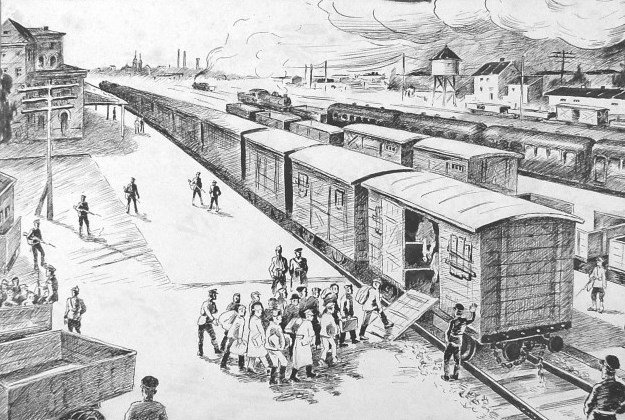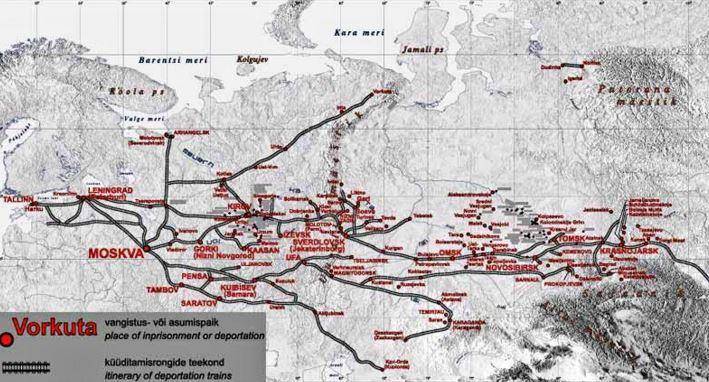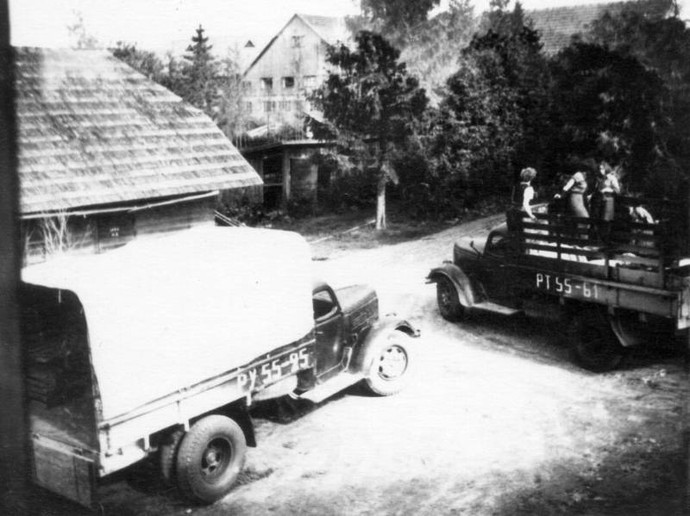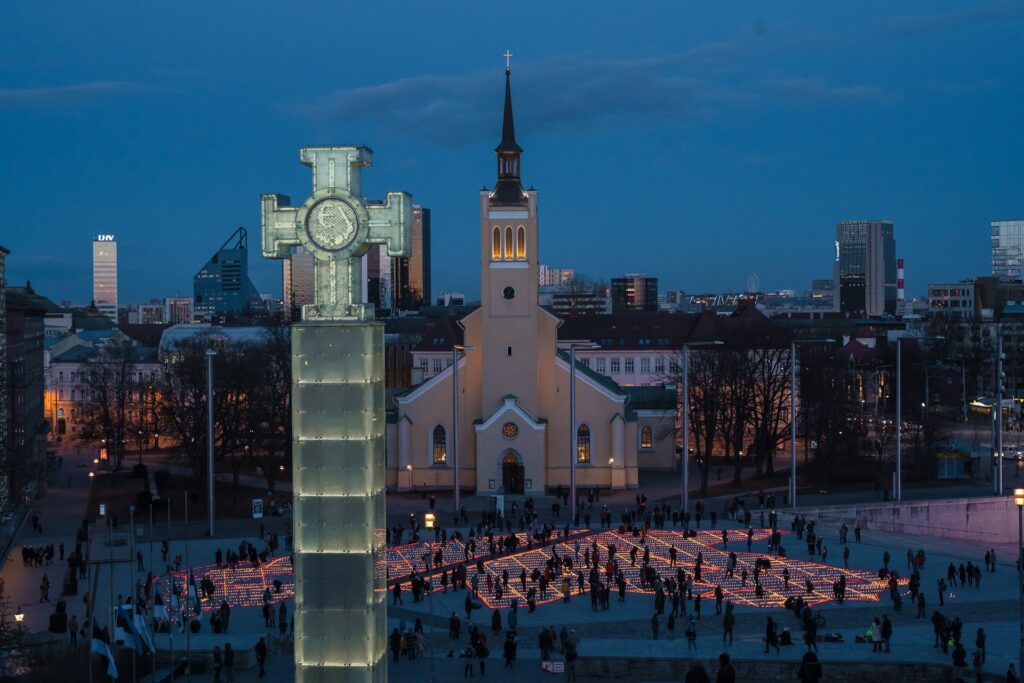On 25 March 1949, the Soviet regime deported 20,000 Estonian men, women, and children to Siberia. In just a few days, nearly three per cent of the country’s population was seized and sent to remote, often inhospitable regions.*
In the summer of 1940 the Soviet Union occupied Estonia, Latvia and Lithuania as a result of the infamous Molotov-Ribbentrop Pact signed between Nazi Germany and the Soviet Union on 23 August 1939. In the aftermath of the Second World War, Estonia lost approximately 17.5% of its population.
The Soviet occupation brought with it an event that until then had only been read about in history books and which became the most horrific memory of the past centuries – mass deportations that affected people of all nationalities living in Estonia. The two deportations that affected Estonia most, on 14 June 1941 and 25 March 1949, are commemorated annually as days of mourning. The March 1949 deportation was the largest, when more than 20,000 people, mostly women and children, were deported from Estonia.
Prologue to the deportations
On 23 August 1939, the Soviet Union and Nazi Germany signed the Molotov-Ribbentrop Pact, the secret protocols that divided Central and Eastern Europe into spheres of influence. On 1 September 1939, Germany launched the Second World War by attacking Poland. On 17 September, the other party to the pact, the Soviet Union, began to play its part, invading Poland from the east and concentrating large forces on the borders of the three Baltic states and Finland.
Although the Estonian government declared its complete neutrality at the beginning of the Second World War, on 28 September 1939 the Soviet Union used direct military threats to force Estonia to sign a so-called mutual military assistance pact, which led to the establishment of Soviet military bases in Estonia.
Similar treaties were also imposed on Estonia’s southern neighbours, Latvia and Lithuania. The seriousness of Soviet pressure and threats was demonstrated by the fact that when Helsinki refused to conclude such a treaty with Moscow, the Soviet Union began to invade Finland in what is known as the Winter War. The international community responded to this Soviet act of aggression by expelling the Soviet Union from the League of Nations.

The Soviet Union occupied and forcibly annexed Estonia, along with Latvia and Lithuania, in the summer of 1940 on the basis of the aforementioned Molotov-Ribbentrop Pact. On the initiative of the Soviet authorities, illegal parliamentary elections were held in the Baltic states with falsified results, which were not recognised by the democratic Western countries.
The Soviet authorities immediately unleashed a reign of terror that also targeted Estonia’s ethnic minorities, such as Jews and Russians. Special emphasis was placed on the elimination of the nation’s cultural, economic, political and military elite.
During the war, Nazi Germany invaded part of the Soviet Union and occupied Estonia from July 1941 to September 1944, after which the Soviet Union re-established its occupation.
Preparations for repressions
Even before the occupation, the Soviet Union had begun preparations to unleash terror on Estonian civil society. The aim of the communist terror was to suppress any possible resistance from the very beginning and to instil great fear in the people in order to prevent any kind of organised general resistance movement in the future.
In Estonia, the planned extermination of prominent and active people, as well as the expulsion of large groups of people, was intended to destroy Estonian society and economy. The lists of people to be repressed were drawn up well in advance. The files of the Soviet security organs show that the Soviet security organs had already collected data on persons to be repressed in the early 1930s.
According to the instructions issued in 1941, the following persons in the territories to be annexed to the Soviet Union and their family members were to be subjected to repression: all members of the former governments, senior state officials and judges, senior military personnel, former politicians, members of voluntary national defence organisations, members of student organisations, persons who had actively participated in anti-Soviet armed struggle, Russian emigrants, members of the security police and police officers, representatives of foreign companies and, in general, all persons with contacts abroad, entrepreneurs and bankers, clergymen and members of the Red Cross. About 23 per cent of the population belonged to these categories.

The Soviet security organs began their repressive activities in Estonia even before its formal annexation by the Soviet Union during the occupation. In June 1940, people were arrested for political reasons, and from then on the number of arrests increased.
On 17 July 1940, the last commander-in-chief of the Estonian Defence Forces, Johan Laidoner, and his wife were exiled to Penza. On 30 July 1940, the President of the Republic of Estonia, Konstantin Päts, and his family were exiled to Ufa. Both General Johan Laidoner and President Konstantin Päts died in Soviet captivity.
Mass deportations
The preparations for the mass deportations began at the latest in 1940 and were part of the overall violence directed against the territories occupied by the Soviet Union in 1939-1940. The Ukrainian and Belarusian territories were the first to be affected by deportations.
The first written reference to the exile of Estonians to Siberia can be found in the papers of Andrei Zhdanov, Stalin’s commissar who oversaw the destruction of Estonia’s independence in the summer of 1940.

The first deportation took place on 14 June 1941, when more than 10,000 people were deported from Estonia.
After the Second World War, when the Soviet Union reoccupied Estonia (after a brief period of Nazi German occupation), the Soviet authorities began discussing the possibility of a new mass deportation.
The secret preparations lasted for over two years, and in March 1949 the occupying forces were ready for another deportation. In the course of the operation that began on 25 March 1949, more than 20,000 people – almost 3 per cent of the Estonian population in 1945 – were rounded up in a matter of days and sent to remote areas of Siberia.
The deportation was demanded by the Communist Party in order to complete “collectivisation” and “eliminate the kulaks as a class”. Almost a third of those designated as “kulaks” managed to escape their captors. In the words of the local Communist Party secretary, Nikolai Karotamm, other families were “grabbed” to “fill the quota”.

The majority of the 1949 deportees were women (49.4 per cent) and children (29.8 per cent); the youngest deportee was less than one year old; the oldest was 95 years old. At least two babies were born on the train. A file still exists on four children who were sent from Rakvere to Siberia without their parents, after being held hostage for two days in an attempt to trap their parents.
Particularly inhumane was the second deportation of children who had been deported in 1941 and were allowed to rejoin their relatives in Estonia at the end of the war.
About 5,000 Estonians were sent to Omsk Oblast, the region directly affected by the Semipalatinsk nuclear test site. Between 1949 and 1956, some 260 atomic and fusion bomb explosions were carried out there. The victims of radiation sickness were left without medical treatment for decades. Sick people and parents of babies born with abnormalities were told that they had contracted brucellosis from animals.
It was not until the late 1950s that deportees who had survived their ordeal were able to return home, but despite partial rehabilitation they remained second-class citizens in the Soviet Union. Many remained under the surveillance of the security services, their confiscated property was never returned to them, and no formal amnesty was ever granted.
* This article was originally published on 25 March 2014 and lightly amended on 25 March 2024.


We must not forget the flowers that Dmitry Linter laid on the grave of Arnold Meri! At least Maxim Reva bolted to his little hole in Saint Petersburg…..
Terrible, terrible, terrible. I hope Putin will be sent to Siberia in Animal wagons to experience it all. God bless Estonia and FOREVER FREEDOM, Democratic society.
Putin didn’t do anything to any of those people so getta f*ck out of here
Putin is fascist too, annexing neighbors, murdering opposition, kidnapping foreigners…etc. You D.K. probably Russian troll.
Video of the candles with memories http://vimeo.com/89475385
Thank you, Seijo, for this video – very poignant.
Russian government still officially claims that all those people (including the infants) were dangerous criminals.
So I wonder why nobody is upset with Nazist or Germans and all the other populations that has been occupied in 1940 never makes this kind of comments and sick videos as you do. You were not the only one to be deported, killed or whatever. My own family has been thrown out their living place, some of them killede and their castle (yes it was a damn castle) has been taken over by the SS that made their own headquarters in there so what? Shall I heat all Germans and Austrians forever now? (yeah Hitler was from Vienna just in case someone forgot it). When this all ethnic thing will finally be over in this country and in this world? When people will finally understand that we are all the same no matter which gender color or nationality we are?? This is just disgusting and it only helps to keep the fights going. Congrats!
Why are you reading about this if you do not feel concerned? Putin is just finishing off what was started by the communists 100 years ago..
I hope. The Nazi supporters deserve to be exterminated!
Look people, this Umberto is a typical Kremlin troll. Fascist regimes have charismatic dictators with hyper-masculine
personality cults. These regimes generally evince a hyper-nationalist
ethos, a cult of violence, mass mobilization of youth, high levels of
repression, powerful propaganda machines, and imperialist projects.
Fascist regimes are hugely popular—usually because the charismatic
leader appeals to broad sectors of the population. Putin and his Russia
fit the bill perfectly.
turd
are you some sort of retard
All atrocities should NEVER be forgotten.
Jim the difference is that Nazi atrocities are well covered, there is a general consensus in the world about what happened. Germany as a country has gone through the process of self-inspection and cleansing. However, as you know- history is written by the winners. What happened in Baltics is not fully aknowledged still by Russia, clearly there is no message of regret. And if something is forgotten, it has a tendency to repeat.
Acknowledging and documenting Soviet atrocities doesn’t minimize Nazi atrocities in any way. So what is your point?
The Nazi atrocities must never be forgotten, however, they were ended in 1945.
The Soviet atrocities started in 1917 and were vigorously continued until they mostly ended in the early 1990s.
The German people accepted, acknowledged and atoned for the horrors of their atrocities, something which successive Russian governments have still not done.
Communism has caused much more suffering and damage to the entire world, over the years, with the sheer number of deaths, abuses and crimes against humanity, as well as the sheer physical destruction, than any other political system.
This is why the former captive and occupied nations cherish and embrace the freedom from the crimes and abuses of their former slave masters during Soviet occupation.
The extent of American and British complicity in the soviet atrocities, such as the cover up of the Katyn forest massacre is also not commonly known.
What is known, but increasingly forgotten is how the West-European and American intellectual establishment, sympathetic to the soviet cause, did everything in its power to deny Soviet human rights abuses during the decades when those outside the Soviet sphere of influence lived in peace and prosperity while the occupied Eastern Europeans faced daily oppression.
If you actually look at British and Polish diplomacy during the later years of the 1930ies you start to wonder if war had been unavoidable in the first place.
a) Hitler was Austrian, but not from Vienna.
b) Mourning for one group of people does not entail forgetting about other groups treated as badly.
Question 1: When will people stop thinking that their own family’s misery is necessarily worse (and hence merits more attention) than that of others?
Question 2: Why should forgetting about atrocities that happened to a group of people (whether ethnically, geographically, or what have you, defined) foster understanding of people’s general equality?
Sorry Jim but Hitler was not from Vienna Austria but rather form Braunau am Inn. “When people will finally understand that we are all the same no matter which gender color or nationality we are?? This is just disgusting and it only helps to keep the fights going. Congrats!” Then of course why should Americans keep reminding themselves about Pearl Harbor? ‘A day that shall live in infamy’. Big deal. That date is over and done with. What ever happened, happened. For us Americans it is ‘no’ big deal. Correct?
An inventive and creative way to tell a difficult story. A story that needs to be remembered so that we may better access our own humanity. The terrors that were committed against the people of Estonia and the people of other nations as well, the terrible acts of conquest, oppression, persecution, attempts at genocide, must never be forgotten. These heinous crimes are not forgotten by peaceful people everywhere that long for a safe world with respect for life in all it’s marvellous forms. All this pain suffered by these innocent victims reverberates for generations in the form of broken families and shattered lives. The politics is public but the pain is personal.
Yes, especially my grandmother with her 4 little daughters
Samantha, if you think that this is really terrible, I agree. But how is Putin connected with this?
Putin – a former KGB officer in the Soviet Union – said in a speech in 2005 that “the collapse of the Soviet empire was the greatest geopolitical catastrophe of the century.” Considering his numerous attempts to restore Russia’s status as an imperial power it enjoyed as the leading country in the Soviet Union – from a rhetoric, to military build-up, to oppressing political opponents, to glorifying the Soviet past (including Stalin), to a failure of acknowledging the Soviet crimes, to a renewed aggression against Russia’s neighboring countries – we can easily see some connection.
Do you even know what means “GEOPOLITICAL catastrophe?”
It was a catastrophe. Not political, but geopolitical. Thousands of russians were living in Soviet Union countries, like Estonia itself. When Soviet Union collapsed, these people stayed in those countries with nowhere else to go, so they had to adapt to a totally new country, new language. The only system of life they knew existing ended.it happened so fast and was a big mess. Russians in Estonia, Estonians in Russia. Countries had to become independent immediately and it wasn’t easy.
Things that were done are terrible!
But don’t mix up different things and people. Don’t take words out of context and listen to actual speech. That speech in particular had nothing to do with Russia’s ambitions
P.S. Soviet never was an empire, soviets were against empires and any kind of royalties 😉
Peace
I completely agree that the term “geopolitical catastrophe” does not mean “political catastrophe” and that misinterpreting someone’s words to prove a point should not be tolerated. I also agree that the collapse of the Soviet Union was a difficult time for everyone.
However, I have no idea what world you have been living in. Communism and the soviet discourse is not USSR. People in the Soviet Union were denied their freedom by closing the borders. They were denied their freedom of speech by censoring every single reference to their national roots. They lived in poverty as the crops were mainly necessary for the Soviet Party officials. If the power belongs to a party that has the absolute rule over everything, it is an empire. And that is exactly what the USSR was.
Honestly, Estonians and other Eastern European nations suffered from the communism that was applied in the USSR exactly the same way jews suffered from the nazis. They were killed, tortured and deported. The international community has yet to acknowledge that and I believe the former Soviet nations have every right to spread light on that issue. Because they were occupied and forced to live in conditions they did not choose. They waited and waited for the justice, for help from the West. And it never came. I am not, in any way, trying to minimize the sufferings of the victims of nationalism. I would just like to reinforce the thought that the post-war communism that Eastern Europe experienced was not socialistic. It was tyranny.
And skipping all the way to where we are with Putin – I believe it’s more than clear to everyone that his agenda is exactly what it is – to restore the glory of the Russian nation by taking back all the are that once were in the beloved USSR. While the quotation of geopolitical catastrophe might not have been the best one (I’m not saying wrong because there is some truth to it), there are an enormous amount of other quotes and rhetoric from Putin that not only suggest, but insists that this is where we are headed. While I might be going too far with the statement, I would still like to say that anyone moralizing or justifying Putin’s recent actions or sayings is either a victim of Russian propaganda or a misanthrope.
And one must never forget who left those countrys in the hands of Soviet russia. The Allies. Us, Uk, France and all the others. They didnt gave a damn, what happend to those people, those nations, countrys. Big democraties my ass
“they didn’t give a damn, what happened to those people, those nations, countrys. Big democraties my ass.” To some degree I accept your feelings. What baffles me, is that up to now, no one has even mentioned England’s most friendliest stab in the back move, (Anthony Eden) along with Roosevelt’s approval and including French, Sweden’s, Italy’s acts of deporting refugees of war, by force, including soldiers back to the Soviet Union. “Operation Keelhaul”. An operation which started in 1944 and ended in 1947. 4- 6million refugees including soldiers who fought against ‘Uncle Joe’. Look it up and then you will admire your former democratic leaders even more.
This is not the origin of the deportations story, but if you prefer this history for Estonia, it´s your choice.
Right. So which is the “correct historical story”? The one written by Stalin’s historians (I presume you are one of the surviving relics) or Putin’s? Or the one written by Ria Novosti?
And they’re forgetting the deportation of Estonian people in 1951 (which was a smaller number of people, but still… they were also deported to Siberia without any time to pack and in the middle of the night because the other Estonians had to remain unaware).
Toomas Paul writes in his book Kirik keset küla (The Church in the Middle of the Village):“Very few have heard of what happened in the early hours of April 1,
1951. A campaign was planned to dispose of Jehovah’s Witnesses and all
their supporters—279 persons in all were captured and deported to
Siberia . . . They were given an opportunity to sign a standard form
renouncing their faith in order to avoid deportation
or imprisonment. . . . Together with the ones arrested earlier, there
were 353 interned, including at least 171 persons only associating with
their congregations.
Youngest deportee was three days old.
and THIS is why Ukraine fights! Never again!
Soviet Union occupied Estonia? Lie! 🙂 Voluntary entry of Estonia into the USSR? Lie! 🙂
The Soviet holocaust took millions of lives and those lives deserve our remembrance just as the German holocaust did and does. What is especially cruel is that Russia under Putin is adding a new chapter to that holocaust in Crimea and Ukraine. What is past is prologue unless we are strong enough to prevent it when it is a crime against humanity and democracy and human dignity. Thank you Estonia for remembering and reminding us all.
Victims??? Estonian was a Nazis nation. In percentage they had more SS soldiers than Germany. Estonia was the first European country “Jews free” and the Concentrament camps were run by Estonians! Mostly of them they were NOT victims but Nazi soldiers or supporters. They deserved to be deported. The biggest mistake was to deport only 20,000 Nazi Estonians and and NOT 100,000. This is the reason because now in Estonia the people still celebrate the “Nazis victims”. what a shame!
First: Both occupants took local men to the Army by FORCE. Second: Estonians and other Russian neighbors have right to fight against occupants (read: Russians), whatever uniform they can get. Russia was and still are the worst enemy of the human kind. There is 100 million people around Russia who know the truth, so please, you can go with your stupid NAZI accusations back to Kremlin.
Majority of the people in Caucasus (Azerbaijan, Georgia, Armenia) and central Asia (Uzbekistan, Kirghistan, Tajikistan, Kazakistan) and also in Latvia, Belarus, Ukriane and Lithuania the majority of population regret the dissolution of Soviet Union. The survey was done by Al Jazeera (a TV close to US) http://america.aljazeera.com/articles/2013/12/19/most-residents-ofexsovietstatessayussrbreakupharmful.html . So it means what you write it is NOT true.
Please read the things you post first. It is not related to the Baltics. “Questions not asked in surveys in Uzbekistan, Lithuania, Estonia, and Latvia.”
tosser
Shame on whether you write it, my great-grandmother, great-grandfather was shot and died of hunger in Siberia for it that they found the farm! https://uploads.disquscdn.com/images/9dc5f83f80e5eab274879417f341078968cb175dec2d8e1b2589e4dcd5978212.jpg
Read it. It is very interesting http://eja.pri.ee/history/Holocaust/holokost_broshure_en.pdf
When the majority of population supported Hitler it is not strange all the population paid the price, also the innocents.
When You have 2 evils, You must choose one. Estonia was autocratic, I can say that, but not nazis.
The joining of the military was quite simple – to join the mountains of cannonfodder being driven to the front like cattle without weapons as we were Estonians and second grade citizens and we were deemed not worthy weapons?
Meet Soviet miniguns and politruk’s Ppsh 41’s if You decide to retreat and not get mowed down by Germans?
OR
Join an organized Nazi force and learn from them, albeit being second grade citizens, combat and get rid of the Soviet Invasion which started murdering people in the KGB cellars already before the war?
Yeaaaahh, that was a pretty obvious choise. Evil choises, both of them.
http://eja.pri.ee/history/Holocaust/holokost_broshure_en.pdf
Great one!! visit http://www.entracomic.com for more EU News
There is something wrong with numbers.
If 20 713 departed persons are 3% of the population, then only 690 433 persons should live at that moment in Estonia. Although, by statistics there lived 1 097 000 persons in Estonia in 1950, which lowers the percent of departed people down to 1.8%